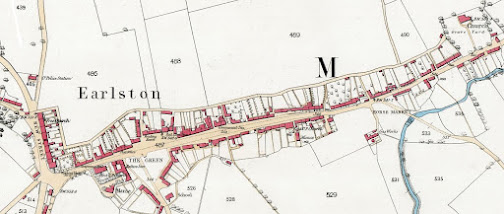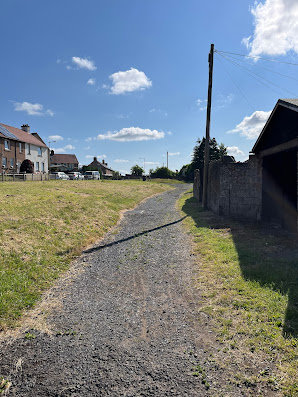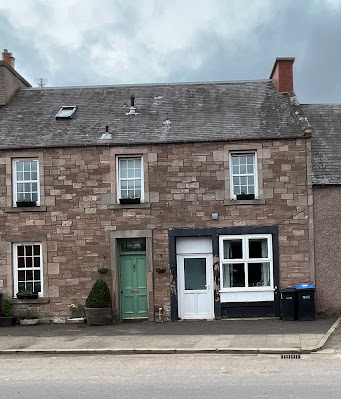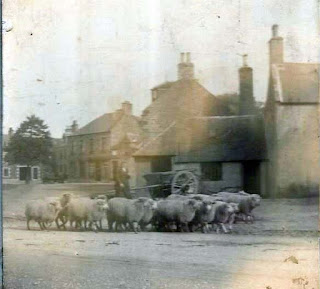Introduction
At a recent meeting of Auld Earlston, a member posed the question 'What did Earlston look like in the age of the horse?'
That prompted a lot of other questions such as ‘Who had horses?; Where did they keep them? and more.
Here then, are the answers to some of those queries.
Looking for clues
There are still some clues to life in Earlston in the age of horses but many of these are being lost to progress.
As a starting point, where were horses and ponies were traded in Earlston?
The Horse Market
The market was located in the east end of the village. The parcel of land, initially known as Horse Market Green, grew into a well respected horse market. By the 1850s newspapers such as The Perthshire Advertiser in the north to the North & South Shields and Durham Gazette and Advertiser in the south regularly reported on the value and variety of horses and ponies traded in Earlston. However, and for whatever reason, by the beginning of the 20th century the horse market had moved. The October 1912 edition of the Berwickshire News and General Advertiser reported on the trade at the Earlston horse market held on the West Green. The grassy area previous known as Horse Market Green was now simply known as the ‘East Green’. The East Green is now disappearing to make way for the new primary school and an access road to a housing development.
 |
| Travellers camping on the Horse Market around 1900. The old primary school wall and gate can be seen in the bottom right of the picture. |
The East Green was a favoured site for travellers and the villagers petitioned to the land owner, Lord Binning, to prohibit camping there. He did not support the petition. However, the green was put to other uses.
On one notable occasion in 1904 a circus encamped there. The Berwickshire News and General Advertiser reported that ‘Sedgwick’s menagerie had taken up position on the East Green and was visited by a large number of people who were greatly pleased with the show and the various performances.’
Later that night an elephant, stabled behind the Red Lion Hotel, escaped and was caught by the hotel proprietor, Mr Smart, devouring a haystack which was destined as feed for the hotel’s horses. By use of ‘strong measures’ the animal was returned to its stable.
Not all horses were bought and sold at the Horse Market. Local newspapers ran classified adverts under ‘Horse, Cattle, Dogs, Etc.’ In the June 20, 1895 edition of the Southern Reporter, Dr Young, the village doctor, advertised -
‘Harness Cob for Sale. Chestnut Mare, 15.1, very strong and hardy, grand worker, sound. Apply Dr Young Earlston’
And when John Newton proprietor of the Red Lion Hotel died in 1894, his estate was sold at public auction. The range and number of items related to horses indicates the amount of equipment needed to run an hotel and meet guests needs.
Included in the sale were -
‘6 useful Harness Horses and Cobs, … 1 Landau, 1 Side-glass Phaeton, 1 Brake, 2 Wagonettes, 1 Chapel Cart … 3 Sets of Double Harnesses, 5 Sets of Single Harnesses with all Stable Utensils and Horse Clothing.’
The sale also included 1 milk cow, presumably kept to provide fresh-milk to the guests and kitchen.
Who owned horses?
Up until the mid 1860s, horses were the only means of transport for Earlstonians, but very few people could afford a coach fare let alone own a horse.
Most horses were draft horses such as Clydesdales which were used on farms for heavy work such as ploughing and pulling other machinery.
 |
| A pair of heavy horses pulling a reaping machine. Note the bondager (female farm servant) in her distinctive costume on the right of the picture. |
Other businesses such as carters, tradespeople and professionals used draft horses or ponies. Dr Young used a horse and gig to attend patients in the areas surrounding Earlston.
 |
| Earlston baker making a delivery to customer |
Where were the horses stabled?
Those who were fortunate enough to own a horse needed to have access to a stable to shelter the animal.
A look through the old Valuation Rolls, an early version of rateable values, shows that a number of houses had stabling either in a yard or in a garden.
Many houses along the north side of the High Street, towards the east end of the village, had stables in the garden. Since some house names haven’t changed we can see that for example, Aitchison Place, Rose Place and Green View had stables.
Owners could access their stables and lead the horse out on to the ‘Back Road’.
This map from 1857 shows the ‘Back Road’ running parallel with the High Street from the west end of the village to the church. The road provided church-goers from the west end of the village a path to the Kirk.
Very little is left of the Back Road, just a short strip from the ‘Postie Close’ (now Kyle Court) for about 100 metres towards the church.
The road is in a poor state but that’s nothing new. An article in the Southern Reporter dated December 1911, reported that concerns had been raised about the condition of the road. The article stated -
‘It is a complaint of long standing that the Back Road is always in a condition to render it a most undesirable thoroughfare to the ordinary pedestrian. Not being a scheduled road it is left severely alone by the County Council and ratepayers, whose property it adjoins, bestow no more attention upon it that they can help, with a view to effecting a much needed improvement in this respect.’
The Valuation Rolls also show that some houses on New Street (now Thorn Street) also had stables. These properties had the advantage that the stables had direct access to public roads.
For example, the 1893 Valuation Roll records that Miss Jane Roger owned a property on New Street that comprised a house, garden, shop and stable. The tenant was a Mr David Jameson who was a carter by trade.
 |
| The early photo of Thorn Street shows an entrance to a stable immediately behind the gig. The arch over the stable entrance can still be seen in the recent photo on the left. |
Who looked after the horses?
 |
| Extract from 1891 Census showing Robert Reid, employed as a groom at the Red Lion Hotel. Credit: Scotland's People |
Where roads safer in the age of the horse?
In August 1895 a four wheeled phaeton carriage carrying an ‘excursion trip’ was returning from Lauder to Earlston. The horse suddenly bolted and one passenger, Mrs Valance who was holding her seventeen month old child, jumped from the carriage. She landed on her shoulder breaking her collar bone. The child was unharmed and both taken home to Galashiels where they received medial treatment.
In December of 1885, a young boy, Robert Moffat was run over by a spring cart near the entrance to the cattle sale-ring in Earlston. He was taken home where he was treated by Dr Young who did not consider the boy’s injuries as serious.
Fortunately, these examples of ‘road traffic accidents’ resulted in, what would be considered today, minor injuries , however one wonders if the injured were left with any lasting damage, for example from bones that didn’t set properly, if they lost their jobs as a result of their injury or how they would be able to pay for any medical treatment they received.
Just like the modern day, there were at least some controls to make roads safer. Local newspapers of the late nineteenth century reported cases appearing in police courts. A frequently reported offence was ‘being drunk while in charge of horse’.
Punishment seemed to be inconsistent. For example, labourer William Dawson, was found guilty of being drunk in charge of a horse and cart in the Market Place and Station Road in Melrose. He was find 25s (£1.25) or ‘suffer twenty-one days imprisonment. Whereas farmer George Beattie (his tenth appearance before the court on this charge!) was ordered to pay a fine of 10s (50p) or suffer seven days imprisonment for the same offence.
In another case heard in Hawick in 1897, a labourer was charged with ‘careless and reckless driving”. The labourer, who was under the influence of drink, was driving rapidly on the wrong side of the road when one of the shafts of his trap struck a horse being ridden by a local postman killing it. The labourer was fined 20s (£1) or ten days imprisonment.
All work and no play?
If you drive from Earlston towards Kelso, about 2.5 miles after leaving the village, you pass the road end to Yarlside Farm. The farm was once the site of Earlston horse racecourse.
When the track was established isn’t known however when the Ordnance Survey conducted a survey of Berwickshire in 1871 the site was known then as the ‘old racecourse’ so its obvious that it is much, much older than the 1870s.
 |
| The old race track in red and Racecourse Plantation Credit: Canmore.org.uk |
When the race course fell out of use and the area was planted as a wooded area.
The Ordnance Survey maps of today (Sheet 74) still show ‘Racecourse Plantation’.
The final journey
For many villagers the only horse drawn carriage ride would be in the village hearse to the churchyard.
A coach-house still stands on Church Street which once housed the hearse (locally known as the ‘hearse hoose!), although these days it is used by Scottish Borders Council for other purposes.
The hearse was shared between churches in Earlston and Lauder to give the recently departed a suitable send off on their final journey.
The photo below shows the ‘hearse hoose’ as it is today together with an early, colourised photo of Church Street showing a pony in front of the hearse coach-house.
The end of an era
At the outbreak of the First World War, the British army was desperate for horses. Within days of the declaration of war army personnel visited towns and villages requisitioning horses deemed suitable.
In early August 1914, troops visited Earlston. They took 4 horses from Colonel Hope at Cowdenknowes and 3 from Robert Smart, the proprietor of The Red Lion Hotel. Other businessmen were affected, Ralph Dodds, a grocer, Robert Murdison, a plumber, and, George Stewart, a dairyman, each had a horse requisitioned.
This signalled the beginning of the end of a way of life where horses played such a central role.
It would take many years for working horses to completely disappear from Earlston. As a child in the 1950s, I can remember Davie Brown delivering firewood (‘sticks’) door to door by horse and cart.
What are your memories?
Do you have any memories of working horses in Earlston? Are there any other clues on the buildings showing links to the age of the horse? Please share them in the comments below.




























